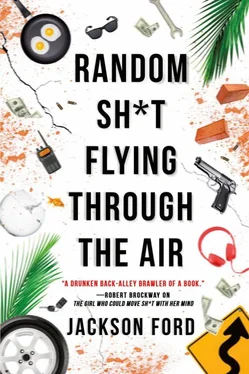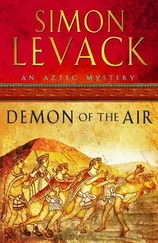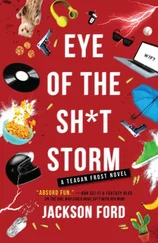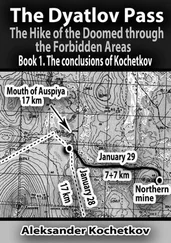“OK,” Africa says slowly. “But what does it matter? They slide under, so what? Why does that make an earthquake?”
“Because of the craton.”
I tilt my head. “The what now?”
“The North American plate isn’t just a single, uniform slab..” She draws a big, messy circle in the centre of America. “Here. It’s a big mass of rock that was formed maybe three billion years ago, and it’s geologically stable. Think of the plate as being really thick in the middle, and thin at the edges.”
“Which is why we don’t get quakes in Ohio,” I mutter.
“Uh-huh. And the craton stops the edge of the plate from moving too far. So—”
Africa rests his oversized knuckles on the black line. “Ya, but the other plate still slides under, yaaw? So what?”
A flash of irritation in Mia’s eyes. “These aren’t, like, smooth sheets of paper. They’re rock. They’re uneven. They’re crunching and grinding and going every which way. Except the thin edge of the North America plate can’t really move very far because of this solid mass of rock behind it, so there’s all this pressure building and building.
“The leading edge? Us? We’re getting pushed upwards. A little bit at a time. And there’s a lot of trapped energy down there. If it gets released…”
I hadn’t realised how pale her face had gotten, but I sure as hell see it now. “The entire coastline would drop six feet, and shoot west thirty,” she says. “All in a matter of minutes. Everywhere, from Mendocino to Vancouver.”
She swallows. “It’s what we call a full-margin rupture. And it’s going to make all of this, all of LA, look like nothing.”
“How?” Africa says, voice very low.
“Easy. LA was an 8.3. If Cascadia ruptures, like you say it will, we could be looking at anywhere from an 8.7 to a 9.2. Maybe even more.”
It’s times like these when I really wish I knew nothing about earthquakes. I’d rather be ignorant. Unfortunately, I’ve learned quite a bit of scary shit over the past couple of days, and there’s one little fact that is conveniently popping to the front of my mind now. Every time you go up a point on the Richter scale, the fault releases thirty-two times more energy than before. And over a much bigger area.
A 9.2… Holy shit.
Holy flying shitballs.
Africa has his hands out in front of him, eyes closed, like he’s trying to wrap his head around it. “Wait, wait. So full margin rupture happens, the whole coast just… goes to the west?”
“It’ll shatter the coast like a broken mirror. Massive cracks, roads destroyed, more than what happened in LA – hundreds of towns and communities completely cut off. And that isn’t the worst of it.”
“How in the hell is that not the worst of it?” My voice has gotten almost as high as Mia’s when I showed her my PK.
“The fault line is under the ocean. The amount of water it’ll displace… We’re talking a tsunami bigger than anyone has ever seen.”
“You’re saying the west coast is going to get shaken to pieces… and then get hit by a tsunami as well ?”
“Us, and Japan.”
“What the fuck are you talking about?” I feel like I’m in an earthquake now , the ground shifting under my feet. “What does Japan have to do with anything?”
“This much energy, the tsunami will go in two directions. It’ll annihilate the east coast of Japan. Hawaii. Maybe even Taiwan and the Philippines, not to mention just about every other Pacific island in the way. We’re talking hundreds of thousands dead in a day. More.”
We all fall silent, looking down at the map. There’s plenty of noise around us, a shifting crowd of people, a whole chaotic city. But right now, all I can focus on is that line. The little black line that runs from California to British Columbia. It looks like nothing. Completely inconsequential. But it’s like a small lump under your breast, or a cough that won’t go away.
It seems impossible that humans still live on the coast. Next to this… this thing . How did we not know about this? Mia’s right – it’s crazy that we hadn’t heard of it. That we just went on living our lives, unaware that the earth could lash out at us at any moment.
My eyes go wide. “No, hang on. Just hang on a second. This line is in the ocean.”
“Ya. So?” Africa says.
“Well, he can’t…” My brain is mush, making my thoughts hard to put into words. “I think he has to be in contact with the ground to set off a fault.”
“How do you know, though?”
“It was on the footage, when he set off the first quake.”
“There’s footage ?” Mia says.
I ignore her. “He kind of… he crouched down, or knelt down. He put his hand on the ground.” The more I speak, the more excited I get. “Even if that isn’t true, I’m pretty sure he’s got a range for his ability – and it probably can’t reach all the way down to the seabed. So we’re OK!”
I look between them, surprised they aren’t getting this. “Well, it’s not as if he’s gonna go scuba diving! He’s like four years old. If he can’t get close to the fault under the ocean, he can’t trigger it. Yes? We’re good. We’re in the clear.”
Mia does not look like we’re in the clear. Mia has her hands to her face, pressed to her eyes.
“What?” I say. Please let it be nothing. Let her have realised she left the oven on at home before the quake. Or that she forgot to pay her taxes. Let it be something normal .
Mia looks sick. Like she’s about to hurl. “The ETS zone.”
“The what now?”
“Episodic Tremor and Slip. An area between the locked zone and slip zone where the mantles meet.”
“Oh, great. I’m so glad you cleared that up.”
“Look, fault lines aren’t uniform. The pressure varies depending on where you are. There are parts where you get these long, drawn-out quakes – episodic tremors. We can’t usually feel them, but they actually increase pressure on the locked zone – the part of the fault that can’t move any more. If Matthew can create a big tremor in one of those zones, he could trigger the big one.”
“ Could? ”
She gives a helpless shrug. “Maybe, yeah.”
“But even if he go this BTS zone…” Africa says.
“ETS.”
“Ya. Even if he gets to it, it’s still out sea?”
“…ETS zones extend under the North American plate. He’ll be able to reach them on land.”
“OK. Fine.” I lean on the table, arms akimbo, like a general considering battle plans. I can’t afford to panic now, or even show it. “Right now, we don’t know where he is. He might have left LA already. But we know where he’s going to be.” I look at Africa. “Yes? Back me up on this.”
“I suppose…”
“Good enough.” I turn to Mia. “The zone you’re talking about. Where is it?”
She just gapes at me.
“OK, this is the part where you point to the map,” I say.
With a trembling hand, Mia starts sketching again, circling a spot in Washington State. “ETS tremors don’t happen on a schedule, but they’re fairly regular. It would be a lot easier for him if he triggered a big pressure release in an area that’s due for one.”
My heart starts to beat faster. “Wait – you’re saying that’s where he’s going to be? That’s the ETS zone?”
But Mia isn’t done. She circles another spot on the map, halfway down Oregon. A third, at the Oregon – California state line. A fourth, a little below that, in the Mendocino National Forest.
And they are big circles. If I had to guess, I’d say they cover hundreds of square miles each.
“These spots,” she says, “are all due a slow-slip tremor. If Matthew releases enough energy in a short space of time, and if he’s at the right place, it could set off Cascadia.”
Читать дальше











